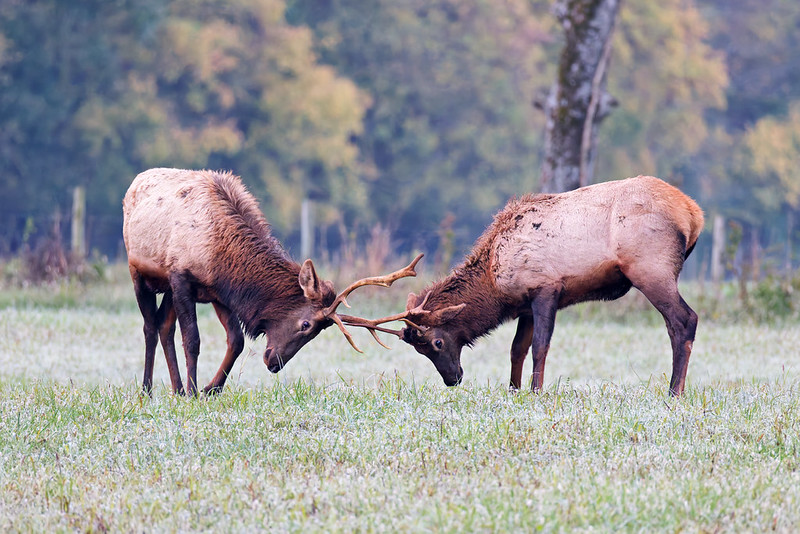Two young bull elk sparring in Boxley Valley caught my attention on a foggy November morning in Arkansas. Their antlers locked together in measured pushes, more practice than combat, as mist softened the sounds across the meadow.
I photographed this scene on November 3rd at the Buffalo National River area. The fog and early light created a calm, silvery backdrop that made the pair stand out against the distant trees.

Wildlife Notes: Post-Rut Sparring Behavior
By early November, the peak of the elk rut in Arkansas is typically over. These young bulls were likely engaged in what’s called maintenance sparring, a lower-intensity form of antler wrestling that helps them refine their skills without the high-stakes pressure of competing for mates.

Bull elk sparring serves multiple purposes beyond the breeding season. Younger bulls use these encounters to practice techniques, test their strength, and establish social hierarchies that will matter in future ruts. The movements are deliberate and controlled, quite different from the intense clashes seen in late September and October when mature bulls fight for dominance and breeding rights.
Boxley Valley is one of the best places in Arkansas to observe elk behavior. The herd was reintroduced to the area starting in 1981, and the population has grown steadily. Early morning and late afternoon offer the best chances to see them in open meadows, especially during the cooler months when they’re more active.
You can also read my related post, Elk Behavior in Boxley Valley, Arkansas, for more about how the herd interacts through the seasons.
The misty conditions on this particular morning seemed to keep the bulls calm. Fog often muffles sound and reduces visibility, which can make wildlife less skittish and more focused on their immediate surroundings.
Photography Notes: Shooting at 800mm in Foggy Conditions
I used my Canon EOS R5 with the RF 200 – 800mm lens at full 800mm reach. I set up at the edge of the field near the road on a tripod, which gave me a clear line of sight across the open grass.
The tripod was necessary at this focal length. At 800mm, even breathing can introduce shake, and the slower shutter speed of 1/400 second meant I needed a rock-solid platform. The bulls were focused on each other and ignored my presence at the field edge.
The fog created tricky exposure conditions. I set the aperture to f/10 and pushed the ISO to 6400 to get a usable shutter speed. I also added +1/3 stop of exposure compensation because the bright fog was trying to trick the meter into underexposing the darker bulls.
At 1/400 second, I was below the usual rule of thumb for wildlife action, but the sparring movements were measured and slow. I timed my shots during the steadier moments when their antlers were locked rather than when they were shifting position. The image stabilization in the RF 200–800mm helped, though with a tripod it’s sometimes better to turn IS off. In this case, I left it on and had no issues.
The soft, diffused light from the fog worked in my favor. It minimized harsh shadows and gave the scene an even, muted tone that emphasized the bulls without distracting highlights. The ISO 6400 noise was manageable with the R5’s sensor, and the atmospheric conditions added to the image rather than detracting from it.
Closing Thoughts
Watching these young bull elk sparring reminded me that not all wildlife action is about high drama. Sometimes the quieter moments, the practice runs and the slow-building skills, are just as compelling to witness and photograph.
Gear and Settings
Photo 1:
Camera: Canon EOS R5
Lens: Canon RF 200–800mm F6.3–9 IS USM
Focal Length: 800 mm
Aperture: ƒ/10
Shutter Speed: 1/400 second
ISO: 6400
Exposure Compensation: +1/3
Photo 2:
Camera: Canon EOS R5
Lens: Canon RF 200–800mm F6.3–9 IS USM
Focal Length: 800 mm
Aperture: ƒ/9
Shutter Speed: 1/500 second
ISO: 6400
Exposure Compensation: +1/3
